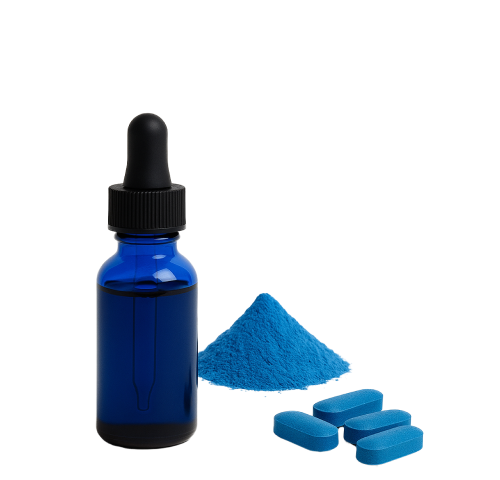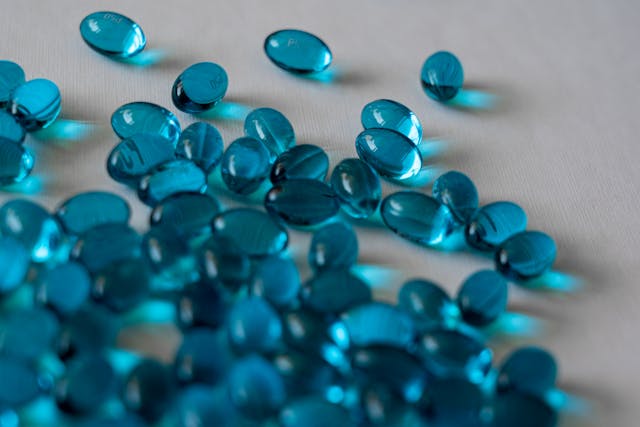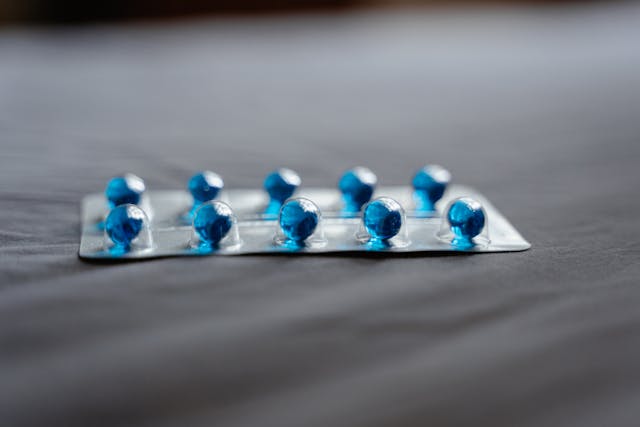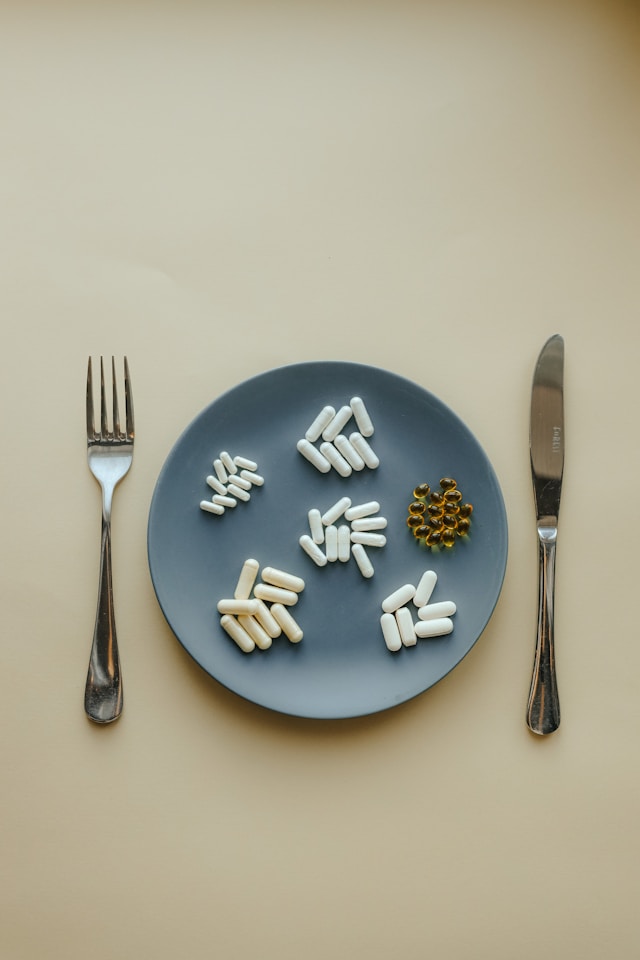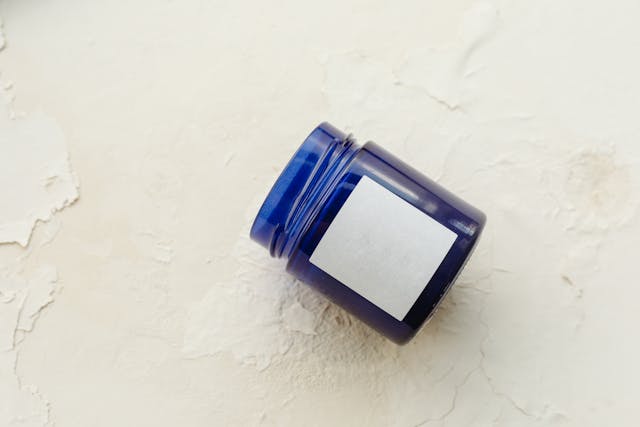Everything You Need To Know About Methylene Blue
A Simple Guide to Its Health Potential
Methylene blue is a compound with a range of uses and potential benefits. Originally developed as a dye, it has also found applications in medicine and health. People use methylene blue as a supplement for its brain health benefits, though understanding its effects and safe dosage is essential. In this article, we’ll go over what methylene blue is, its uses, potential benefits, and side effects, providing you with all you need to know about this versatile stimulant.
- Published: November 22, 2024
- Last Updated: June 3, 2025
- TL;DR
- What Is Methylene Blue?
- How Methylene Blue Works
- Methylene Blue Benefits
- Methylene Blue Dosage
- Dosage Benchmarks
- Methylene Blue Book Recommendations
- Andrew Huberman On Methylene Blue
- Methylene Blue Supplement Options
- Methylene Blue Supplement Timing
- Synergistic Stacks
- Daily Routine With Methylene Blue
- Methylene Blue Side Effects
- Is Methylene Blue Safe?
- Medical Disclaimer
-
-
TL;DR Snapshot (30-Second Read)
Methylene Blue (MB) is a century-old “Swiss-army dye” that’s gone from coloring textiles to powering up mitochondria.
Why biohackers care: Low-dose MB can act like an octane booster for cellular energy and brain performance.
At-a-glance perks & cautions
- ✓ Sharpens short-term memory and focus
- ✓ Supports mitochondrial ATP production (think: more cellular energy)
- ✓ Synergizes with red-light therapy for recovery
- ⚠️ Can interact with SSRIs/SNRIs (serotonin-syndrome risk)
- ⚠️ Only pharmaceutical-grade MB—never aquarium dye
-
What Is Methylene Blue?
A Vivid History in One Sentence
Born in 1876 as the first synthetic aniline dye, methylene blue’s bright azure quickly leapt from fabric vats to medical vials.
Why It’s Back on the Longevity Scene
- Mitochondrial Mojo: Acts as an alternative electron carrier, helping tired mitochondria pump out ATP.
- Low-Dose Nootropic Buzz: Early human studies (0.5–4 mg/kg) show sharper memory recall.
- Stack-Friendly: Pairs nicely with red/near-infrared light panels, CoQ10, and breathwork routines.
-
How Methylene Blue Works
1. Mitochondrial Electron Donor – “Jump-start for your cell batteries.”
Inside every cell, the electron-transport chain is a conveyor belt that makes ATP—the energy currency you spend on thinking, moving, and repairing tissue. Stress, aging, or toxins can slow down its first step, which is known as Complex I. Methylene blue wedges itself into the line and hands electrons to the next station, so the belt keeps rolling and ATP production stays high even when Complex I is dragging. Think of it as a portable jumper cable for tired mitochondria.
2. Antioxidant Recycler – “Self-recharging antioxidant.”
Methylene blue flips back and forth between a blue (oxidized) and a clear (reduced) form. During that flip it grabs spare electrons from NADH and other redox partners, then donates them to neutralize reactive oxygen species—those rust-like molecules that age your cells. Because it constantly recharges itself, a tiny amount can mop up a lot of oxidative stress without being used up.
3. Nitric-Oxide Modulation – “Traffic control for blood flow.”
Nitric oxide (NO) dilates blood vessels, but too much can gum up mitochondrial enzymes. Low-dose methylene blue tempers runaway NO while leaving enough for healthy circulation. The net result is steadier blood flow to the brain and muscles—users often describe it as feeling “clear-headed but calm.”
4. Photodynamic Synergy – “Solar-panel mode.”
Shine red or near-infrared light on tissue that contains methylene blue and the dye absorbs that light energy. The excited MB then transfers the energy to surrounding molecules, triggering a burst of cellular repair signals—more collagen in skin, faster muscle recovery, and even antimicrobial effects against certain pathogens. It’s the same principle behind light-activated dental cleansers, just harnessed for performance and longevity.
In short, methylene blue is a multi-tool: it jump-starts ATP, scrubs free radicals, keeps blood flow balanced, and turns red-light sessions into turbo-charged recovery periods—all with milligram-level doses.
-
Methylene Blue Benefits
Methylene blue has garnered attention for its potential therapeutic properties in addressing neurological and cardiovascular concerns. This compound is being explored for its effects on cognitive decline, neurobiological disorders, and focus enhancement, offering a promising outlook for future medical applications.
- Support for Cognitive Health: Methylene blue shows potential in combating age-related cognitive decline, particularly in conditions such as Alzheimer’s and Parkinson’s disease.
- Neurobiological Disorders: It may be an effective treatment for traumatic brain injuries and neurodegenerative disorders, offering hope for improved brain health.
- Hormetic Effects: Methylene blue offers therapeutic benefits at lower doses but can become toxic at higher amounts, making proper dosing essential.
- ADHD Support: Methylene blue may serve as a safer alternative to manage ADHD, improving focus and productivity without withdrawal symptoms or tolerance buildup.
If you want to learn more about the extensive methylene blue benefits, consider checking out our article about its advantages.
-
Methylene Blue Dosage
The effects of methylene blue are dose-dependent, meaning that while lower doses may provide significant health benefits, higher doses can lead to adverse effects.
- Recommended Dosage Range: Pharmaceutical-grade methylene blue is typically considered safe at doses of 0.5 to 2 mg per kilogram of body weight. For instance, an 80 kg individual should aim for a daily dose between 40 and 160 mg, though starting with lower amounts is often safer. We recommend consulting your doctor before choosing a dosage for yourself.
- Hormetic Effects: Methylene blue benefits are observed at lower doses, such as improved cognitive function and neuroprotection. Higher doses, however, can pose risks like methemoglobinemia, which affects oxygen transport in the blood.
- Quality Matters: Always choose pharmaceutical-grade methylene blue supplements to avoid contaminants, including heavy metals, which may be present in non-regulated products.
- Gut Microbiome Considerations: Higher doses may negatively impact the gut microbiome by disrupting beneficial bacteria due to methylene blue’s antimicrobial properties.
- Monitoring Responses: Start with the lowest effective methylene blue dose, monitor how your body responds, and adjust as needed under medical supervision.
Methylene blue’s potential as a cognitive enhancer and neuroprotective supplement is promising, but its proper use requires attention to dosing, product quality, and individual health conditions. Consulting a healthcare provider is essential to safely maximize the benefits while minimizing risks.
-
Dosage Benchmarks
Finding the right amount of methylene blue depends on your reason for using it. Dosage needs vary for cognitive support, red-light therapy pairing, or clinical treatment. It’s always best to start with the lower end of the range and slowly adjust.
-
Longevity and brain support: Most users take between 0.5–2 mg per kg of body weight. Starting with 0.25 mg/kg for the first week is often recommended to see how your body responds.
-
Red-light (PBM) stack: A flat dose of 10–20 mg is typically taken about 30 minutes before an LED or near-infrared session. This timing supports the way methylene blue interacts with light.
-
Medical use only (antidote for methemoglobinemia): Doses of 1–2 mg per kg are given through an IV in emergency settings. This is not for home use and should only be done under hospital supervision.
-
Typical noticeable range: Many users report feeling a mental lift between 5–15 mg total, even at lower dosages.
Always follow dosage guidelines and observe how your body reacts before adjusting. Using methylene blue correctly can support different wellness goals without risking side effects from too much too soon.
-
-
Methylene Blue Book Recommendations
If you’re interested in understanding the science, history, and potential of methylene blue, several books provide in-depth insights. These resources are excellent for anyone seeking a clearer picture of methylene blue benefits, uses, and safety.
- Methylene Blue: The Magic Bullet by Dr. John Lieurance: This book analyzes the historical development and therapeutic applications of methylene blue. John explains how this compound evolved from a simple dye into a versatile tool in medicine.
- The Ultimate Guide to Methylene Blue by Mark Sloan: A comprehensive guide that breaks down methylene blue uses, benefits, and side effects. It also covers dosing strategies, including insights into the methylene blue dosage chart for safe and effective use.
- The Ultimate Guide to Molecules That Could Save Your Life by Levin O. Trent: This book takes an in-depth look at methylene blue’s molecular mechanisms and its potential to support health, including brain function and longevity.
- The DIY Guide to Methylene Blue by Brent Andersen: Perfect for beginners, this guide explains how to safely use methylene blue at home, including its benefits and practical tips for incorporating it into daily routines.
These books are valuable resources for anyone curious about methylene blue. They provide detailed information on methylene blue supplements, proper dosing, and its therapeutic possibilities while highlighting the importance of safety and medical guidance.
-
Andrew Huberman On Methylene Blue
Andrew Huberman, a neuroscientist, has highlighted methylene blue for its potential in enhancing cognitive function and overall brain health. While he acknowledges its benefits, he also stresses the importance of approaching its use cautiously, given its unconventional history and emerging popularity in wellness circles.
- Cognitive Benefits: According to Andrew Huberman, methylene blue benefits include improved memory and enhanced cognitive performance, particularly when used as a stimulant.
- Combination Use: He suggests that methylene blue can be more effective when combined with caffeine and B vitamins, potentially amplifying its effects on brain function.
- Dosing Recommendations: The recommended dose he mentions is approximately 10 milligrams, typically taken in the morning for optimal results.
- Oral Absorption: Methylene blue is well-absorbed when taken orally, making it a convenient option for those exploring its use as a supplement.
- Caution Advised: Huberman notes its unusual history, including its use in cleaning fish tanks, and advises users to approach methylene blue supplements carefully, keeping an eye on emerging research.
While Andrew Huberman acknowledges the promising potential of methylene blue, he emphasizes the need for caution and proper dosing. Its ability to act as a cognitive stimulant and enhance brain health makes it intriguing, but consulting a healthcare professional is essential for safe use.
“So as long as we’re talking about maintaining or boosting cognitive function, here’s one I’ve never tried, but you and I have talked a little bit about, and it’s still seen as kind of renegade, but it’s becoming more commonplace, and that’s methylene blue.”
Andrew Huberman -
Methylene Blue Supplement Options
Methylene blue supplements are available in various forms, offering flexibility in how you incorporate them into your routine. Whether you’re looking for convenience or specific applications, there’s an option to suit your needs.
- Liquid Form: Methylene blue is available as a liquid, which can be easily measured using a dropper. This form allows precise control over your daily methylene blue dosage, as guided by a dosage chart. You can also use an injection to transfer methylene blue if you don’t want to take it orally.
- Capsules: Methylene blue capsules offer a convenient option for those who prefer pre-measured doses. These are easy to include in your daily supplement routine and reduce the risk of over- or under-dosing.
- Lozenges or Troches: These are designed for slow absorption through the cheek (buccal area), allowing a more gradual uptake of methylene blue into the bloodstream. This method may support steady effects throughout the day.
- IV Use: Methylene blue can also be administered through an intravenous (IV) drip, but this is strictly limited to hospital or clinical settings. It’s typically used for specific medical purposes under direct supervision.
- Skincare Products: Some skincare products now include methylene blue for its potential anti-aging benefits. These products are designed to improve skin health and appearance by targeting oxidative stress at the cellular level.
Methylene blue supplements provide various ways to enjoy its potential benefits, from cognitive support to skin health. Always choose high-quality products and follow dosage guidelines to maximize effectiveness while minimizing methylene blue side effects.
-
Methylene Blue Supplement Timing
Getting the timing right can make a big difference in how methylene blue works for you. When you take it and how often you cycle it can affect everything from energy to sleep.
-
Ideal time to take it: Morning or early afternoon is best, as methylene blue may interfere with sleep if taken later in the day.
-
Helps maintain daytime energy: Taking it earlier helps support alertness and avoid any disruption to your nightly rest.
-
Short-term cycling option: Many people follow a 5 days on, 2 days off pattern. This can help reduce the chance of building tolerance.
-
Longer cycle option: Another popular approach is 3 weeks on, followed by 1 week off. This break allows your body to reset its response to methylene blue.
Understanding the right timing and cycling methods can help you get more consistent results with methylene blue. It also makes it easier to stick to a routine that supports your focus, energy, and long-term use.
-
-
Methylene Blue Synergistic Stacks
Methylene blue works well on its own, but pairing it with the right habits or supplements can make its effects feel more noticeable. These combinations are popular because they target energy, brain function, and recovery from different angles.
-
CoQ10 or Ubiquinol: Feeds into the same electron pathway as methylene blue, helping support more steady energy levels and mental sharpness throughout the day.
How much: 100–200 mg ubiquinol with breakfast, ideally alongside your usual methylene blue dose. -
Creatine Monohydrate: Helps store extra phosphate so your cells can use the ATP produced more efficiently—useful for better workouts and quicker recovery.
How much: 5 g daily in water or a shake; take methylene blue 30 minutes before training. -
Red or Near-Infrared Light Panels: Red/NIR wavelengths work with methylene blue by boosting its energy signal, often used to support faster recovery and better skin tone.
How much: 10–20 mg of methylene blue, then wait 30 minutes before using light panels for 5–10 minutes at 630–670 nm or 810 nm. -
Moderate Cardio or Circuit Training: Exercise builds new mitochondria, and methylene blue helps fuel them—together, they support better endurance and post-workout focus.
How much: 0.5–1 mg/kg of methylene blue 30 minutes before a light run or circuit workout; often cycled five days on, two off.
Pairing methylene blue with the right stack can help support clearer thinking, more energy, and faster physical recovery—all while keeping your supplement plan simple and consistent.
-
-
Integrating Methylene Blue Into Daily Routines
Adding methylene blue to your day doesn’t have to be complicated. With just a few small adjustments, you can use it in ways that support focus, energy, and recovery—no matter what your schedule looks like.
-
Mito-Morning Routine: A 10-minute start to the day with 1 minute of box breathing, 5 minutes of red-light therapy, 10 mg of methylene blue under the tongue, and 4 minutes of dynamic stretching.
-
Office-Worker Focus Stack: Take 5 mg of methylene blue with 200 mg of L-theanine at 8 a.m., then use 25-minute Pomodoro work blocks. Add a blue-light filter after sunset to reduce visual strain.
-
Athlete Recovery Stack: Take 0.5 mg/kg of methylene blue 30 minutes before a sauna or red-light session. Follow with 5 g of creatine and electrolytes after your workout.
Whether you’re starting your morning or winding down from training, methylene blue can fit into your day with just a little planning. Keeping it simple helps you stay consistent and see better results over time.
-
-
Methylene Blue Side Effects
While methylene blue offers potential health benefits, it is important to understand its possible side effects. This compound interacts with serotonin levels and has specific medical considerations that users should be aware of before making it a part of their daily routine.
- Impact on Serotonin Levels: Methylene blue can affect serotonin in the brain, which is why it is sometimes used in psychiatry to treat conditions like depression. However, this interaction can increase the risk of serotonin syndrome, particularly in individuals taking SSRIs or other medications affecting serotonin.
- Pregnancy Concerns: Methylene blue is generally not recommended during pregnancy due to potential risks to the baby. Always consult a healthcare provider for advice.
- Temporary Staining: A harmless but noticeable side effect is the temporary blue staining of the tongue and urine, which occurs after taking methylene blue capsules or supplements.
- Dosage-Dependent Side Effects: At higher doses, methylene blue may cause additional side effects, such as gastrointestinal discomfort or headaches. Following a methylene blue dosage chart is critical for safe use.
Understanding methylene blue side effects is essential to maximize its benefits while minimizing risks. Consulting with a healthcare provider can ensure safe use, especially for those with specific health conditions or taking medications.
-
Is Methylene Blue Safe?
Methylene blue is generally considered safe when used at low doses and with proper guidance. Still, safety depends on personal health factors, supplement quality, and any medications you may be taking. Here are the key things to know before adding it to your routine:
-
Dose Matters: Methylene blue is safe at low doses and exceeding recommended doses can lead to side effects, including methemoglobinemia, which impairs oxygen transport in the blood.
-
Product Quality: Always choose top-of-the-line methylene blue supplements to avoid contaminants like heavy metals, which may be found in lower-quality products.
-
Drug Interactions: It can interact with certain medications, especially SSRIs, increasing the risk of serotonin syndrome. Consult a healthcare provider before use if you are on medications.
-
Medical Conditions: People with specific conditions, such as G6PD enzyme deficiency, should avoid methylene blue due to the risk of hemolytic anemia.
-
Pregnancy and Breastfeeding: There is not enough human safety data, so it’s best to avoid methylene blue during pregnancy or while breastfeeding until more research becomes available.
-
Benign Side Effects: Temporary blue-green urine or stool and a bluish tongue can occur. These are harmless and usually fade quickly.
-
Purity Rule: Always choose USP/EP-certified products that contain at least 99% methylene blue. Avoid aquarium or textile-grade versions, as they may contain harmful solvents or metals.
-
Start Low, Go Slow: Begin with about 0.25 mg/kg and monitor your mood, sleep, or heart rate variability (HRV). If you feel good, slowly adjust the dose.
When used correctly, methylene blue can be a safe addition to your routine. Just be mindful of interactions, quality, and dosage to reduce the chance of side effects. Always consult your doctor before starting.
-
-
Medical Disclaimer
The information provided in this article is for informational purposes only and is not intended as medical advice, diagnosis, or treatment. Methylene blue and its potential benefits, uses, and side effects should be discussed with a qualified healthcare professional before starting supplementation. Always consult a healthcare provider to determine if methylene blue is safe and appropriate for your individual health needs, especially if you are taking medications, have pre-existing medical conditions, or are pregnant or breastfeeding. The use of methylene blue should be based on professional guidance and an understanding of its proper dosage and potential risks.
-
-
References
- Methylene Blue As An Anti-Aging Drug
- Methylene Blue And Alzheimer’s Treatment
- Methylene Blue Dosage
- Why Take Methylene Blue
- The Science And Benefits Of Methylene Blue
- Methylene Blue: The Long and Winding Road from Stain to Brain
- Methylene Blue For Treating Malaria
- Methylene Blue as Antidote For Cyanide And Carbon Monoxide Poisoning
- Methylene Blue and Its Potential in the Treatment of Traumatic Brain Injury
